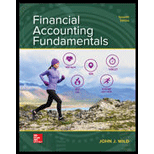
FINANCIAL ACCT.FUND.(LOOSELEAF)
7th Edition
ISBN: 9781260482867
Author: Wild
Publisher: MCG
expand_more
expand_more
format_list_bulleted
Concept explainers
Question
Chapter 2, Problem 17E
To determine
The monetary benefits or profits earned by the company after deducting the amount of dividends being paid and distributions if any, to the investors. When a company's rate of dividend distribution is higher than the rate of its revenues then the negative balance of the said account is known as accumulated deficit. A company requires retained earnings more in the initial period of its growth to fulfill its primary goals and survive as a financially sound company in the long run.
To prepare: Statement of retained earnings.
Expert Solution & Answer
Want to see the full answer?
Check out a sample textbook solution
Students have asked these similar questions
Additionally, the firm pays $925,000 in legal fees.
Can you solve this general accounting question with accurate accounting calculations?
Daley Industries wishes to develop a single predetermined overhead rate. The company's expected annual fixed overhead is $420,000, and its variable overhead cost per machine hour is $3.25. The company's relevant range is from 200,000 to 650,000 machine hours. Daley expects to operate at 520,000 machine hours for the coming year. The plant's theoretical capacity is 850,000 machine hours. The predetermined overhead rate per machine hour should be: a. $3.85 b. $4.06 c. $3.75 d. $4.25
Chapter 2 Solutions
FINANCIAL ACCT.FUND.(LOOSELEAF)
Ch. 2 - Amalia Company received its utility bill for the...Ch. 2 - On May 1, Mattingly Lawn Service collected $2,500...Ch. 2 - Liang Shue contributed $250,000 cash and land...Ch. 2 - A trial balance prepared at year-end shows total...Ch. 2 - Bonaventure Company has total assets of...Ch. 2 - Provide the names of two (a) asset accounts, (b)...Ch. 2 - Prob. 2DQCh. 2 - Prob. 3DQCh. 2 - Prob. 4DQCh. 2 - Prob. 5DQ
Ch. 2 - Prob. 6DQCh. 2 - Prob. 7DQCh. 2 - Prob. 8DQCh. 2 - Prob. 9DQCh. 2 - Prob. 10DQCh. 2 - Prob. 11DQCh. 2 - Prob. 12DQCh. 2 - Prob. 13DQCh. 2 - Prob. 14DQCh. 2 - Prob. 15DQCh. 2 - Prob. 16DQCh. 2 - Prob. 17DQCh. 2 - Prob. 18DQCh. 2 - Prob. 1QSCh. 2 - Prob. 2QSCh. 2 - Prob. 3QSCh. 2 - Prob. 4QSCh. 2 - Prob. 5QSCh. 2 - Prob. 6QSCh. 2 - Prob. 7QSCh. 2 - Prob. 8QSCh. 2 - Prob. 9QSCh. 2 - Prob. 10QSCh. 2 - Prob. 11QSCh. 2 - Prob. 12QSCh. 2 - Prob. 13QSCh. 2 - Prob. 14QSCh. 2 - Prob. 15QSCh. 2 - Prob. 1ECh. 2 - Prob. 2ECh. 2 - Prob. 3ECh. 2 - Prob. 4ECh. 2 - Prob. 5ECh. 2 - Analyzing account entries and balances A1 Use the...Ch. 2 - Prob. 7ECh. 2 - Prob. 8ECh. 2 - Prob. 9ECh. 2 - Prob. 10ECh. 2 - Prob. 11ECh. 2 - Prob. 12ECh. 2 - Prob. 13ECh. 2 - Prob. 14ECh. 2 - Prob. 15ECh. 2 - Prob. 16ECh. 2 - Prob. 17ECh. 2 - Prob. 18ECh. 2 - Prob. 19ECh. 2 - Identifying effects of posting errors on the trial...Ch. 2 - Prob. 21ECh. 2 - Prob. 22ECh. 2 - Prob. 23ECh. 2 - Prob. 1PSACh. 2 - Prob. 2PSACh. 2 - Prob. 3PSACh. 2 - Prob. 4PSACh. 2 - Prob. 5PSACh. 2 - Prob. 6PSACh. 2 - Prob. 7PSACh. 2 - Prob. 1PSBCh. 2 - Prob. 2PSBCh. 2 - Prob. 3PSBCh. 2 - Prob. 4PSBCh. 2 - Prob. 5PSBCh. 2 - Prob. 6PSBCh. 2 - Prob. 7PSBCh. 2 - Prob. 2SPCh. 2 - Prob. 1GLPCh. 2 - Prob. 2GLPCh. 2 - Prob. 3GLPCh. 2 - Prob. 4GLPCh. 2 - Prob. 5GLPCh. 2 - Using transactions from the following assignments,...Ch. 2 - Prob. 7GLPCh. 2 - Prob. 8GLPCh. 2 - Prob. 1AACh. 2 - Prob. 2AACh. 2 - Prob. 3AACh. 2 - Prob. 1BTNCh. 2 - Prob. 2BTNCh. 2 - Prob. 3BTNCh. 2 - Prob. 4BTNCh. 2 - Prob. 5BTNCh. 2 - Prob. 6BTNCh. 2 - Prob. 7BTN
Knowledge Booster
Learn more about
Need a deep-dive on the concept behind this application? Look no further. Learn more about this topic, accounting and related others by exploring similar questions and additional content below.Similar questions
- Need accounting questionarrow_forwardWhat is the total manufacturing costs charged to work in process during Novemberarrow_forwardWhich accounting concept supports recording bad debt expense before accounts are actually uncollectible? a) Full disclosure principle b) Matching principle c) Going concern concept d) Materiality concept need answerarrow_forward
- Express the gross profit amount as a percentage of the sales amount for Denver.arrow_forwardSolved balance sheet December 31, 20XXarrow_forwardRose Equipment Corporation (LEC) paid $6,800 for direct materials and $11,500 for production workers' wages. Lease payments and utilities on the production facilities amounted to $7,400, while general, selling, and administrative expenses totaled $4,200. The company produced 7,500 units and sold 5,900 units at a price of $7.75 per unit. What was LEC's net income for the first year in operation? Need answerarrow_forward
- Solve with explanation and accountingarrow_forward6 PTSarrow_forwardDaniil Consulting is a consulting firm. The firm expects to have $64,500 in indirect costs during the year and bill customers for 8,600 hours. The cost of direct labor is $85 per hour.1. Calculate the predetermined overhead allocation rate for Daniil Consulting. 2. Daniil completed a consulting job for Sarah Miller and billed the customer for 22 hours. What was the total cost of the consulting? 3. If Daniil wants to earn a profit equal to 80% of the cost of a job, how much should the company charge Ms. Miller?arrow_forward
arrow_back_ios
SEE MORE QUESTIONS
arrow_forward_ios
Recommended textbooks for you
 College Accounting, Chapters 1-27AccountingISBN:9781337794756Author:HEINTZ, James A.Publisher:Cengage Learning,
College Accounting, Chapters 1-27AccountingISBN:9781337794756Author:HEINTZ, James A.Publisher:Cengage Learning,


College Accounting, Chapters 1-27
Accounting
ISBN:9781337794756
Author:HEINTZ, James A.
Publisher:Cengage Learning,

The KEY to Understanding Financial Statements; Author: Accounting Stuff;https://www.youtube.com/watch?v=_F6a0ddbjtI;License: Standard Youtube License